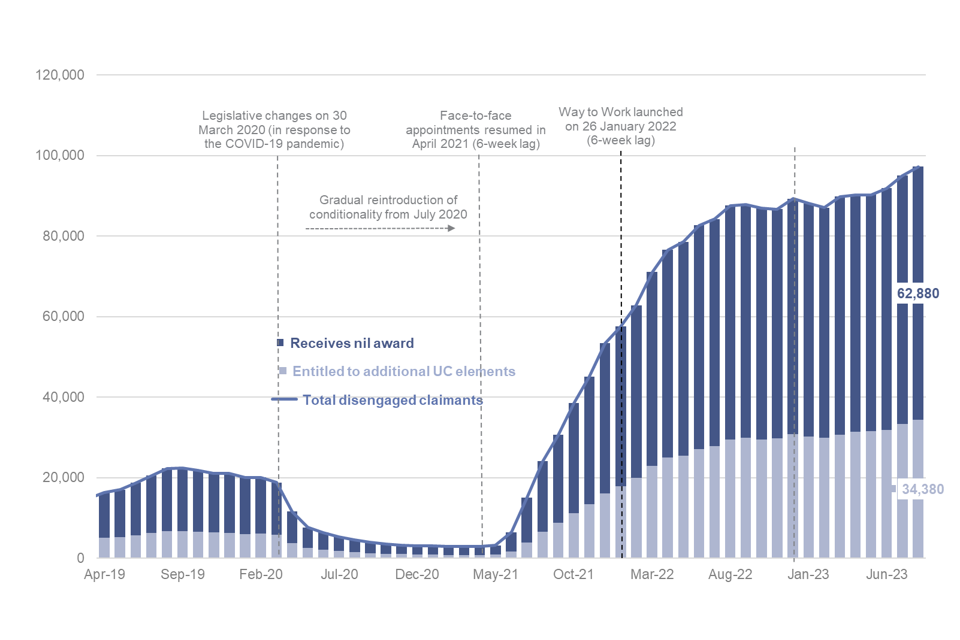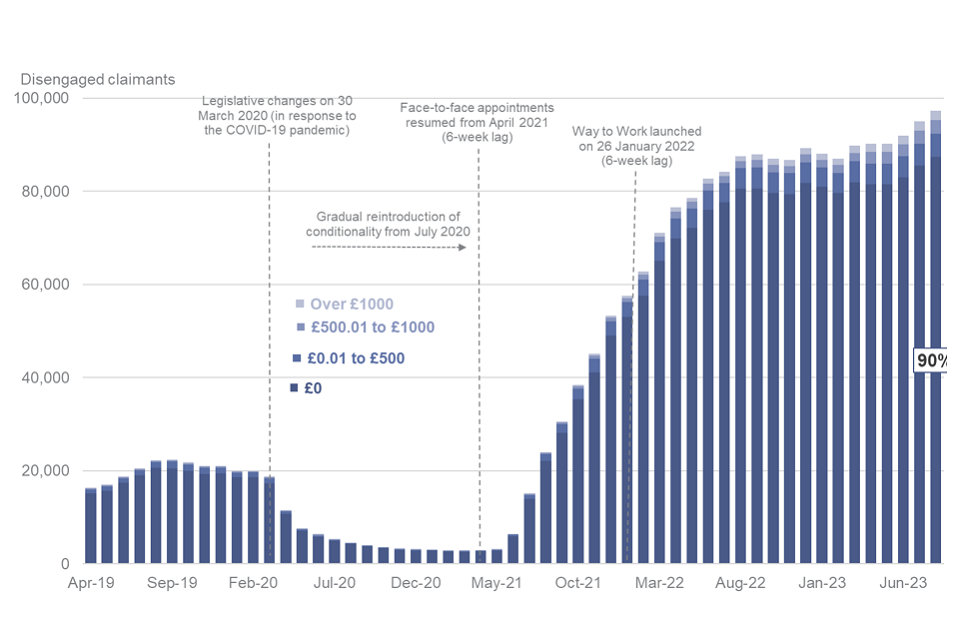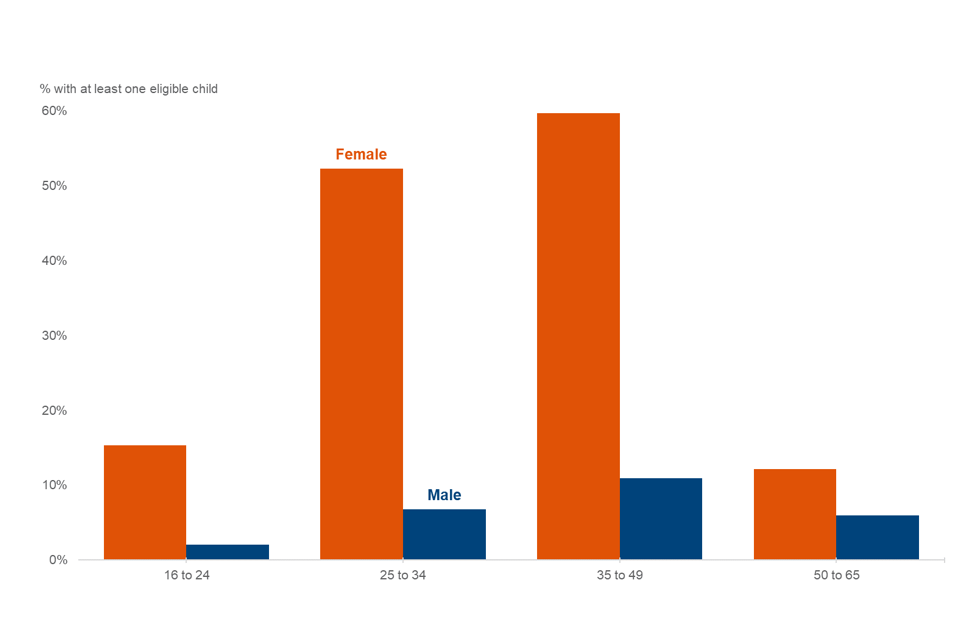Sanctioned disengaged claimants management information, April 2019 to August 2023
Updated 21 December 2023
1. Main stories
The main stories are:
- in August 2023 5% (97,000) of the Universal Credit (UC) sanctionable caseload was disengaged for 6 weeks or more
- of these claimants disengaged for 6 weeks or more 65% were on Nil award and 35% were entitled to additional UC elements
- in August 2023, 3% (51,000) of the UC sanctionable caseload was disengaged for 6 months or more
- of these claimants disengaged for 6 months or more 69% were on Nil award and 31% were entitled to additional UC elements
- male claimants are more likely to be disengaged as in August 2023 the 6-week disengaged rate for males was 7% compared to 2% for females
- younger claimants are more likely to be disengaged as in August 2023 the 6-week disengaged rate for claimants aged 16 to 24 was 8% compared to 2% for claimants aged 50 to 65
2. What you need to know
Claimants are required to meet agreed conditions to be eligible for Universal Credit (UC). If a claimant does not meet one or more conditions of their benefit claim without good reason, their benefit could be stopped or reduced. This is a benefit sanction.
Low and lowest level sanctions can be applied if a claimant fails to attend (FTA) any mandatory appointments.
A claimant must, however, be given the chance to explain why they have not complied with any set requirements that can lead to a sanction, and this will be taken into consideration by a decision maker.
FTA sanctions are open-ended and reduce the claimant’s standard allowance by 100%.
A disengaged claimant is defined as a claimant who has an open low or lowest level FTA sanction, and it has been 6 weeks (42 days) or more since the claimant failure date. The disengaged duration is the duration from the claimant failure date to the claimant re-compliance date (where one exists). More information on this is available in the Methodology section.
It was recently announced that Department for Work and Pensions (DWP) would be strengthening the sanctions process for people who should be looking for work, by seeking new primary legislation to enable the closure of claims of individuals on an open-ended sanction for over six months (this only applies to people solely eligible for the UC standard allowance).
DWP will also use the Government’s Targeted Case Reviews to review UC claims of individuals on an open-ended sanction and disengaged for over eight weeks, ensuring they receive the right entitlement.
The data in this publication is the latest available for statistics on sanctioned disengaged UC claimants.
These statistics cover the period from April 2019 to August 2023.
The statistics in this publication are for Great Britain.
3. Disengaged claimants
3.1. Volumes of disengaged claimants
A small but growing proportion of the UC sanctionable caseload is disengaged.
Percentage of sanctionable UC caseload disengaged for 6 weeks or more, by disengaged duration, April 2019 to August 2023.

The overall proportion of the sanctionable UC caseload that are disengaged is low, peaking at 5% in August 2023. Since reaching its lowest rate, at around 0% during the pandemic, rates of disengaged claimants increased rapidly until around September 2022. After this time, they have continued to rise but at a steadier rate. In August 2023, 4% of claimants were disengaged for 3 months or more, 3% for 6 months or more and 2% for 9 months or more.
Around 97,000 UC claimants have been disengaged for 6 weeks or more, and this figure continues to rise.
Total UC claimants disengaged for 6 weeks or more, by disengaged duration, April 2019 to August 2023

In August 2023, over 97,000 UC claimants had been disengaged for 6 weeks or more. Of these 53% (51,000) had been disengaged for 6 months or more, 12% (12,000) for 6 to 8 months and 41% (40,000) of claimants had been disengaged for over 9 months. In recent months, the proportion disengaged for over 6 months has increased, which has largely been driven by those disengaged for 9 months or more, for example from 23% in August 2022 to 41% in August 2023. Claimants who have been disengaged for 6 to 8 months remain the smallest proportion, at 12% in August 2023. 19% of claimants were disengaged for 3 to 5 months in August 2023 and 28% of claimants were disengaged for 6 weeks to 3 months.
In August 2023, the total number of UC claimants who had been disengaged for 6 weeks or more peaked at 97,000. This number has steadily been increasing in recent months. In March 2021, numbers of disengaged claimants were at their lowest (under three thousand). Following the reintroduction of face-to-face appointments in 2021, this figure has continued to rise, considerably exceeding pre-pandemic levels of disengaged claimants, which peaked at 22,000 in September 2019.
3.2. Impact of disengagement on UC award
Most claimants disengaged for 6 weeks or more receive a nil award whilst sanctioned.
UC claimants disengaged for 6 weeks or more, by entitlement to additional UC elements, April 2019 to August 2023

Most disengaged claimants receive a nil award. There is consistently a higher proportion of disengaged claimants receiving a nil award, compared to receiving additional UC elements, across the whole time series. In August 2023, 63,000 (65%) of claimants were in receipt of a nil award.
Most claimants disengaged for 6 months or more receive a nil award whilst sanctioned.
UC claimants disengaged for 6 months or more, by entitlement to additional UC elements, April 2019 to August 2023

Claimants disengaged for 6 months or more follow a similar trend and in August 2023 over 51 thousand UC claimants had been disengaged for 6 months or more. Of this number, 69% (35,000) were receiving a nil award. As with UC claimants who had been disengaged for 6 weeks or more, there is consistently a higher proportion of disengaged claimants receiving a nil award, compared to receiving additional UC elements.
3.3. Characteristics of disengaged claimants
Male claimants and younger claimants are disproportionately likely to be disengaged.
3.3.1. Gender
Proportion of sanctionable UC caseload disengaged for 6 weeks or more, by gender, April 2019 to August 2023

Males are consistently more likely to be disengaged than females and this trend can be seen from April 2019 to August 2023. In August 2023 the proportion of sanctionable UC claimants who had been disengaged for 6 weeks or more was 7% and 2% for males and females respectively. Although disengaged claimants remain a small proportion of overall UC claimants, the number of disengaged claimants has been steadily rising in recent months for both males and females.
3.3.2. Age
Younger UC claimants are disproportionately likely to be disengaged.
Proportion of sanctionable UC caseload disengaged for 6 weeks or more, by age group, April 2019 to August 2023

Younger UC claimants are consistently the most likely to be disengaged and this trend can be seen from April 2019 to August 2023. In August 2023 the proportion of sanctionable UC claimants who had been disengaged for 6 weeks or more aged 16 to 24 was 8%. 6% were aged between 25 to 34. 4% were aged between 35 to 49 and 2% represented disengaged claimants aged between 50 to 65. While these proportions remain a small amount of overall UC claimants, this figure has been steadily rising in recent months.
3.3.3. Declared earnings
Nearly all disengaged claimants have no declared earnings.
UC claimants disengaged for 6 weeks or more, by declared take home pay, April 2019 to August 2023

Disengaged claimants with no declared earnings have consistently accounted for the majority of the disengaged UC claimants, from April 2019 to August 2023. This represented around 90% of disengaged UC claimants in August 2023. A further 5% declared earnings of £0.01 to £500 in that month, 3% declared earnings of £500.01 to £1,000 that month and 2% declared earnings over £1,000 for that month.
3.3.4. Additional elements
The additional elements group is older, with more females, than the nil award group.
+6 week disengaged claimants entitled to additional elements only, by gender and age group, August 2023

+6 week disengaged claimants receiving a nil award only, by gender and age group, August 2023

Disengaged Claimants who are entitled to additional elements tend to be older on average than disengaged claimants who receive a nil award. In August 2023, 4,170 (14%) of disengaged claimants who were entitled to additional elements were those aged 16 to 24. 10,320 (34%) were aged 25 to 34, 11,620 (38%) were those aged 35 to 49 and 4,310 (14%) were aged 50 to 65.
For those receiving a nil award, 39% (21,010) of disengaged claimants were aged 16 to 24. 18,050 (34%) of disengaged claimants were aged 25 to 34, 10,330 (19%) were aged 35 to 49 and 4,140 (8%) were aged 50 to 65.
Similarly, there seems to be less gender variation between disengaged claimants who are entitled to additional elements. Female claimants account for 40% of disengaged claimants who are entitled to additional elements, whereas female claimants only comprise 15% of claimants in receipt of a nil award. Across all age groups, male disengaged claimants were more likely to receive a nil award than female disengaged claimants, accounting for 85% (45,310) of disengaged claimants.
Younger male claimants are the demographic most likely to be in receipt of a nil award, with males aged 16 to 24 accounting for 32% of all nil awards.
Female disengaged claimants aged 25 to 49 are more likely to have dependents and therefore be entitled to additional elements.
Proportion of claimants disengaged for 6 weeks or more with at least one eligible child, by gender and age group, August 2023

Across all age categories it is considerably more likely for female disengaged claimants to have at least one eligible child, therefore qualifying for additional elements. In August 2023 the most likely age group to have at least one dependent child was claimants aged 35 to 49 years old.
For those aged 16 to 24, 15% of disengaged females and 2% of disengaged males had at least one dependent. Of those aged 25 to 34, over half (52%) of disengaged females and 7% of disengaged males had at least one dependent. 60% of disengaged females aged 35 to 49 had at least one dependent, compared to 11% of disengaged males. At age 50 to 65, 12% of females and 6% of males had at least one eligible child.
3.4. Cost of disengaged claimants
Claimants disengaged for 3 months or more were paid over £11 million in August 2023 and over £17 million was paid to claimants disengaged for 6 weeks or more
Total payments to disengaged UC claimants after adjustments and deductions by disengaged duration, April 2019 to August 2023

In recent months the amount of money paid to disengaged UC claimants has peaked, alongside numbers of disengaged claimants. In August 2023, £17m was paid to those who had been disengaged for 6 weeks or more. £11 million was paid to those who had been disengaged for 3 months or more.
4. More information
Data sources
The data for these statistics was obtained via SAS Enterprise Guide 8.3.
It is important to note that because this publication is a management information release these statistics should not be compared to official statistics, as the quality assurance process is less extensive than that of official statistics. The methodology used to identify sanctioned disengaged claimants also differs from that used to calculate the national sanction rate which is published in the quarterly benefit sanctions statistics publication.
Status
These statistics have not been assessed by the UK Statistics Authority and have not been designated as National Statistics. This publication is a management information release.
Method
The methodology used in the disengaged analysis, calculates the number of days between the claimant failure date to the re-compliance date. The number of disengaged days is calculated for each Assessment Period (AP). After merging datasets, each sanction is validated using sanction deductions on the claimant statement so that sanctioned APs are only kept where a sanction deduction is present. Where no re-compliance date exists, the disengaged period is estimated up to the end of the last month in which a sanction deduction is present.
A disengaged claimant is defined as a claimant who has an open FTA sanction, and it has been 6 weeks (42 days) or more since the claimant failure date. The disengaged duration is the duration from the claimant failure date to the claimant re-compliance date (where one exists) or to the end of the last month in which a sanction deduction is present.
A sanctioned disengaged claimant on nil award is where the sanction takes away 100% of their standard allowance and they have no additional elements such as housing costs within their universal credit entitlement.
Sanctions are applied on a daily rate for each day they apply. The daily rate is calculated based on the relevant standard allowance amount for the claimant over the year, divided by 365. Universal Credit is paid on a monthly award basis - this means that for months with fewer than 31 days the claimant will receive a residual amount.
Numbers on the graphs have been rounded to the nearest ten.
Principles followed in the compilation and release of these tables.
Although the tables are not Official Statistics, they have been produced as far as possible in line with the Code of Practice for Statistics. This is a voluntary application of the Code of Practice for Statistics, due to the publication being a management information release, rather than official statistics.
The code is built around 3 main concepts, or pillars:
-
trustworthiness – is about having confidence in the people and organisations that publish statistics
-
quality – is about using data and methods that produce assured statistics
-
value – is about publishing statistics that support society’s needs for information
The following explains how we have applied the pillars of the Code in a proportionate way.
Trustworthiness
DWP analysts work to a professional competency framework and Civil Service core values of integrity, honesty, objectivity, and impartiality. Analysts have produced these statistics and conducted rigorous quality assurance in line to the standards usually applied to ad hoc releases. Background and methodology information is also included in the release.
The analysis has been signed off by the expert lead analyst and the Department’s Head of Profession for Statistics was consulted on the production and publication process and the timing of the publication was pre-announced.
Care has been taken to ensure only those who needed to see the analysis prior to publication had access to it.
Quality
The analysis uses the Department for Work and Pensions (DWP) management information data. This data was initially produced for internal purposes and differs to the published Benefit Sanction Statistics official statistics under development. Whilst it has not been through the same levels of rigorous quality assurance as official statistics care has been taken to ensure that reliable and accurate data has been obtained.
The data in this publication mainly covers Great Britain (England, Scotland, and Wales), however, a small number (less than 1%) of cases from Northern Ireland may have been included in some of the high-level figures.
Value
The publication of this ad hoc release ensures the statistics are equally available to all users as well as providing transparency and up to date data to the public. It also offers value to society by helping monitor the sanctions regime.
For more detail on how the sanction rate is calculated, see the ‘Sanction Rates’ section of the background information and methodology document for the benefit sanctions statistics publication.
5. Where to find out more
The official statistics information regarding sanction rates, conditionality, sanction decisions and durations can be found in the benefit sanctions statistics publication.
Read the latest benefit sanctions statistics.
See other DWP management information and ad-hoc analyses.
See the list of upcoming DWP ad-hoc statistical releases.
6. Contact information
For statistics enquiries only, email: labour.marketstatistics@dwp.gov.uk
For media enquiries please contact the DWP Press office.
